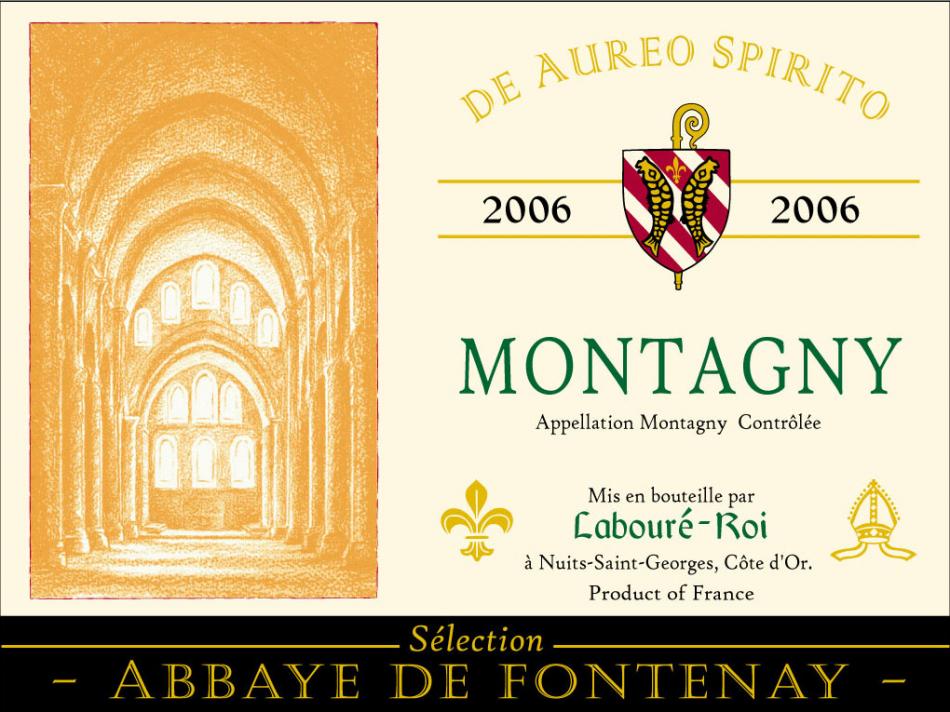勃艮第的精神堡垒-----枫特奈的西多会修道院(ABBAYE DE FONTENAY)
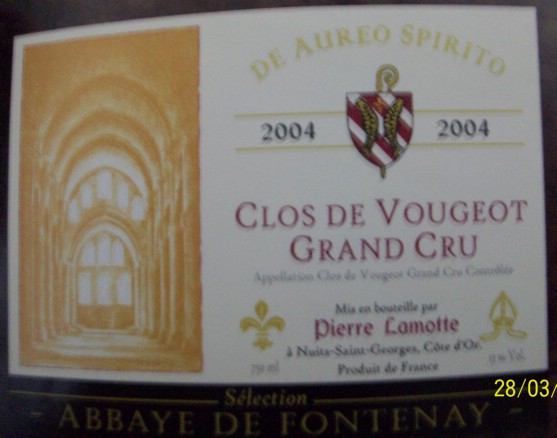 在巴黎人的心目中,只有Bourgogne才是唯美的。一千多年前,西多会的传教士们在索恩河畔种下了第一株葡萄树,开启了Burgundy wine 辉煌的历史进程。Wine 在宗教中具有举足轻重的地位,耶稣在最后的晚餐中曾举起杯对门徒们说:“喝吧,这是我的血。”葡萄酒也就成为教会中用于祭祀的重要祭品,对于潜心侍奉上帝的修士们来说,酿制葡萄酒便成为他们神圣的职责。
在巴黎人的心目中,只有Bourgogne才是唯美的。一千多年前,西多会的传教士们在索恩河畔种下了第一株葡萄树,开启了Burgundy wine 辉煌的历史进程。Wine 在宗教中具有举足轻重的地位,耶稣在最后的晚餐中曾举起杯对门徒们说:“喝吧,这是我的血。”葡萄酒也就成为教会中用于祭祀的重要祭品,对于潜心侍奉上帝的修士们来说,酿制葡萄酒便成为他们神圣的职责。
11世纪在法国勃艮第地区创建的天主教西多会,其对于积累和发展葡萄种植和酿酒工艺起到了功不可没的作用,今天的许多声名显赫的名园都曾是西多会创建并发展传承下来的。Bourgogne的红酒可以说是法国传统葡萄酒的典范,而枫特奈的西多会修道院则是勃艮第的精神源泉和堡垒。
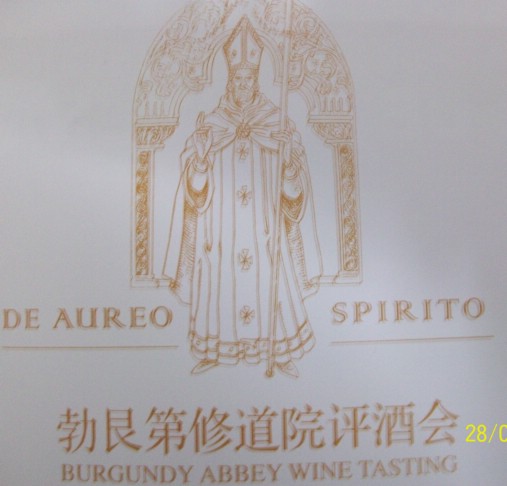 公元1118年,西多会的St.Bernard院长在Montbard幽静的小山谷组织建设枫特奈修道院,虽然教堂还未建成,St.Bernard就已经故去,但是ABBAYE DE FONTENAY还是以朴素、沉静、雄伟的风格,按照圣博纳生前的意愿建成。
公元1118年,西多会的St.Bernard院长在Montbard幽静的小山谷组织建设枫特奈修道院,虽然教堂还未建成,St.Bernard就已经故去,但是ABBAYE DE FONTENAY还是以朴素、沉静、雄伟的风格,按照圣博纳生前的意愿建成。
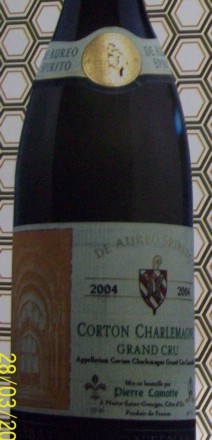 枫特奈修道院的戒律之一就是要求修道士们种植葡萄并酿制成酒。修道士们为了寻找最佳的土壤种植葡萄,会用舌头去分辨土壤中的成分;事实上正是这些修士们最先提出Cru的概念,所以枫特奈修道院的葡萄酒一直传承着不断寻求Grand Cru并提高酒质的传统,其酿制的葡萄酒赢得了越来越高的声誉。
枫特奈修道院的戒律之一就是要求修道士们种植葡萄并酿制成酒。修道士们为了寻找最佳的土壤种植葡萄,会用舌头去分辨土壤中的成分;事实上正是这些修士们最先提出Cru的概念,所以枫特奈修道院的葡萄酒一直传承着不断寻求Grand Cru并提高酒质的传统,其酿制的葡萄酒赢得了越来越高的声誉。
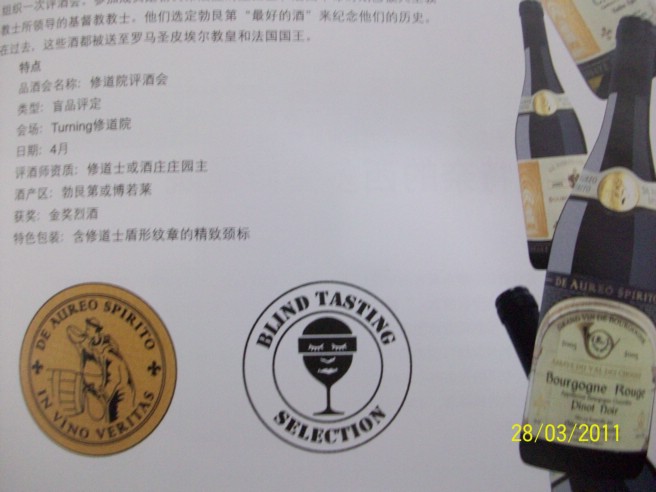 很久以前,每年四月的第一个星期一,在济贫会竞卖会之后,勃艮第的大教会协会组织一次“盲品”品酒会。参加成员是勃艮第酒庄的庄园主和修道士们,他们共同选定“最好的酒”来纪念他们的历史。在过去,“最好的酒”都被进贡给罗马教皇和法国国王,获奖的酒会获得金奖烈酒的特色瓶颈标------含修道士盾形纹章。
很久以前,每年四月的第一个星期一,在济贫会竞卖会之后,勃艮第的大教会协会组织一次“盲品”品酒会。参加成员是勃艮第酒庄的庄园主和修道士们,他们共同选定“最好的酒”来纪念他们的历史。在过去,“最好的酒”都被进贡给罗马教皇和法国国王,获奖的酒会获得金奖烈酒的特色瓶颈标------含修道士盾形纹章。
我在网上找到这样一张图, 和阿宝的这个比较接近,
这也是ABBAYE DE FONTENAY选的酒,在Laboure-Roi装瓶的?
修道院和酒庄是什么关系呢? 捐赠?
我看明白了。应该是带加工产品。有点类似HOSPICE DE BEAUME的酒。应该是修道院的酒是各个酒农酿好以后,经过BLIND TASTING后选出来的。最后在瓶子上还是会有酒农的信息。
阿宝,有说错吗?
枫特奈修道院的戒律之一就是要求修道士们种植葡萄并酿制成酒。修道士们为了寻找最佳的土壤种植葡萄,会用舌头去分辨土壤中的成分;事实上正是这些修士们最先提出Cru的概念,所以枫特奈修道院的葡萄酒一直传承着不断寻求Grand Cru并提高酒质的传统,其酿制的葡萄酒赢得了越来越高的声誉。
是枫特奈修道院的修士们自己种植葡萄自己酿酒,好的田都是修道院自己的。不是问农民收葡萄,
修道院应该是会有一部分自己的最好的田,BY好像最早就是修士们酿酒。图上几个Grand Cru应该就是修道院自己好地,自己酿的酒
勃艮第的酒最早就是修道院发展起来的, 酒标上的田是修道院自己的,酒是修道院自己酿的。酒商只是向修道院买木桶中的期酒,到时候由酒商装瓶而已。
http://en.wikipedia.org/wiki/Clos_de_Vougeot
The Clos de Vougeot vineyard was created by Cistercian monks of C?teaux Abbey, the order's mother abbey. The land making up the vineyard was purchased by the Cistercians, or donated to them, from the 12th century to the early 14th century. The initial vineyard consisted of donations in 1109 to 1115.[3] The vineyard was complete, and a wall had been built around it, by the year 1336.[1] It served as the flagship vineyard of the Cistercians, and has been a highly recognised name for centuries.
Chateau de Clos de Vougeot, situated inside the wall, was added in 1551 by rebuilding and enlarging a small chapel and some other buildings previously existing at the site. From 1945, this building has served as headquarters of the Confrérie des Chevaliers du Tastevin.[3]
In the French Revolution, all vineyard possessions were taken from the church by the French state, and sold off to private buyers. In 1818, the chateau and vineyards of Clos de Vougeot was bought by Julien-Jules Ouvrard, who also bought the Romanée-Conti vineyard in 1819. Ouvrard later moved to Chateau de Gilly, another former Cistercian property, but continued to take in an interest in the vineyards of Clos de Vougeot, which was then a monopoly.[3] After Ouvrard's death, Clos de Vougeot passed to his three heirs, but continued to be operated as a single property until 1889, when the heirs put it up for sale. It was bought by six Burgundy wine merchants, leading to a subdivided vineyard for the first time since its creation more than 700 years earlier. After that, the holdings have been progressively subdivided by inheritance and land sales. In the early 2000s, Clos de Vougeot was split among more than 80 owners.[1]
One of the 1889 vineyard buyers, Léonce Bocquet, also bought the chateau, and initiated renovations of a part of it. In 1920, the chateau came into the hands of Etienne Camuzet, who was vineyard owner in Vosne-Romanée and politician. He put it to the disposal of the Confrérie des Chevaliers du Tastevin,[3] and on November 29, 1944 sold it to the organisation Société civile des Amis du Chateau du Clos de Vougeot ("Friends of the Chateau du Clos de Vougeot"), which gave the Confrérie des Chevaliers du Tastevin a 99 year lease on the property.
看到这段: In the French Revolution, all vineyard possessions were taken from the church by the French state, and sold off to private buyers
Perhaps more than any other wine-producing region of France there is ancient viticultural history here. At least it feels that way when you stand amongst the vines. Naturally other regions have their own history, their own connections to the Roman Empire (Ausone and Figeac in St Emilion being two particularly good examples), their abbeys and monasteries, ancient guardians of the vine. But here in Burgundy the history seems just that little bit richer. Viticulture was certainly already established when the region was under Roman dominion, perhaps two millennia ago. No doubt other regions can match this history, but few have such wonderful records, and such determined expansion, led by the numerous monasteries that sprang up after the 6th century. As these religious institutions grew in power and influence, their land-holdings grew to match, largely as the result of generous benefactions from wealthy land-owners no doubt looking to seek favour in the afterlife. By the 12th century Burgundy was covered with vines, and the wines produced were achieving widespread fame.
In later times the wines first came to the attention of the Dukes of Burgundy, rich and extremely powerful noblemen, and then they also became known to the king, in particular the Roi-Soleil or Sun-King, Louis XIV, perhaps best known for his grand palace at Versailles. With such prestigious endorsements it is not surprising that international trade developed, and large négociant houses sprang up in Nuits and Beaune to take appropriate advantage. It was perhaps a golden era for the region, but with the Revolution at the end of the 18th century all this came to an end. Vineyards belonging to both the nobility and the church were seized and broken up, and with the arrival of the Napoleonic laws of inheritance - under which estates can not be inherited by one heir alone, but must be divided between all rightful offspring - this microscopic parcellation of once extensive domaines would be further exacerbated.
18世纪的时候拿破仑的法典,规定了私有的家族继承制度。
所以也造成了今天,BY的复杂性。
就好比如一个家里有几个孩子,分同块地。每个人对酒的认识不同。所以酿出来风格也不同。
当然地也是有关系的。同一块地处于葡萄藤处在不同的坡度上也会有关。
这也解释了,同一块Grand Cru价格会差十几倍。
而且在BY,Grand Cru的价格,和质量不是觉得都比1er好。好的1er价格也不菲。
没错, 法国大革命时期, 教会所拥有的很多葡萄园被政府没收而分买给不同的私有者。
枫特奈修道院(ABBAYE DE FONTENAY)是最早的西多会修道院,走的是自给自足的葡萄种植和酿酒路线, 并不经营经商,把还在木桶中的酒卖给酒商,以维持生计。这个传统保留到现在, 装瓶、宣传、经营是酒商的事。在修道院的网站上是不会提及酿酒和葡萄种植的。
想起浙江某位蜂农亲戚,他们世代养蜂酿蜜,每年都卖给不同的商家让他们装瓶的(或者商家再卖给冠生园之类),自己只留一点自用和送人,至于卖给的商家怎么装瓶贴什么标,甚至蜜卖哪去了,外头的口碑怎样,如何宣传的他们一概不知道。偶们去哪里也只管吃他们自己留的蜂蜜![]()
枫特奈修道院的戒律之一就是要求修道士们种植葡萄并酿制成酒。所谓的农民酒都是1789年法国大革命以后,所有葡萄园被分割成若干小块出售,但并不代表修道院就没有自己所允许保留的![]()
这话太绝对了。偶觉得修道院和农民还是有点区别的。。。这篇说的是修道院修士酿的酒,然后卖给酒商装瓶,和农民走的是平行路线,只是修道院历史更悠久,并且没有经营性质不去宣传。好像修道院和农民是不会发生买卖关系的。所以这说的是两码事。怎么又说到农民上去了呵呵
拿Rhone的JL Chave来说,他的酒分Selection和不标Selection.
时至今日,修道院,济慈园是没有地的了。
他们通过农民,酒商的捐献酿好的酒,每年会有拍卖会。来标上自己的酒。
真真的大图 表示得很清楚了,Sellection--这葡萄这酒来自枫特奈的西多会修道院,装瓶的是Labour'-Roi酒商,所以说是精神堡垒:)没说这是Domaine
地就像是照相机,给不会用的人用神灯,还不知道拍出来的是什么呢。所以地虽然重要,也不是全部。倒是最后从成品中挑选好坏直接一些。虽然有限制,但是可靠。
馋嘴说的是正解,把酒送到历史上的“精神堡垒”去Blind tasting, 好酒挂“金牌” ,这是当地人对宗教信仰的虔诚, 我的原文说的就是勃艮第的精神堡垒-----枫特奈的西多会修道院![]()
我不是正解。只是你们两方的点不在一起。都想多了。酒,喝了再论。不要像以前娶媳妇一样,蒙个头布,什么都看不清楚。这样不好。
我觉得阿宝又饶回去了,既然是修道院自己酿的酒,那还要评比什么啊?
应该是酒商酿好酒, 送修道院评比挑选了,再贴上Selection ABBAYE DE FONTENAY
所以, 酒还是酒商买的葡萄或者农民自己的葡萄酿的, 不是修道院的地,也不是修道院酿的.
修道院做的工作就是挑选评比.
在15,16世纪,欧洲最好的酒就出自类似枫特奈的众多修道院中,18世纪法国大革命以后,《拿破仑法典》打破了这个传统。所以建于11世纪的枫特奈修道院就只能成为“精神堡垒"![]()
恩。真真是正解。
这其实和Hospice de beaune同样的道理。农民,酒商捐赠酒。然后贴上修道院的名字。
然后农民,酒商装瓶。酒卖掉后的所得捐赠给穷人。
JULIEN的逻辑:
酒商的酒 ---> 参加修道院评比---> 贴上修道院挑选的标(可能部分或者全部收益给修道院)
我觉得比较靠谱
对的。比如Roumier哪天脑子怀特了,把Roumier Musingy给了这个教会。教会也不是傻子就拿下。(一般名气大的农民不干这傻事)
那么这酒就是
ABBAYE DE FONTENAY Musigny Grand Cru 3000 Mis en bottle en Domaine Roumier.
哦。个么我搞错了。其实不是早就跟你们说了嘛,同HOSPICE DE BEAUME差不多性质的。最多么就是ABBAY买回来的,HdB是人家送的。
我也刚搞清楚大家纠结的问题![]() 是我误会了
是我误会了
16世纪前
修道院自己的地--->修道院自己酿的酒
18世纪后-----现在
农民的地--->农民酿的酒 --> 修道院评酒会评选(精神堡垒)---> 酒商收购“带金牌”的好酒装瓶发售
大家搞的是这问题吗?
请登录后再发言
> 杯酒人生
最新话题:
美食记2025赛季全盲品个人赛积分榜(截止到10月10日) (杯酒人生)
美食记2025赛季全盲品个人赛积分榜(截止到9月5日) (杯酒人生)
美食记2025赛季全盲品个人赛积分榜(截止到8月1日) (杯酒人生)
美食记2025赛季全盲品个人赛积分榜(截止到6月13日) (杯酒人生)
美食记2025赛季全盲品个人赛积分榜(截止到6月6日) (杯酒人生)
美食记2025赛季全盲品个人赛积分榜(截止到5月30日) (杯酒人生)
美食记2025赛季全盲品个人赛积分榜(截止到5月9日) (杯酒人生)
美食记2025赛季全盲品个人赛积分榜(截止到5月2日) (杯酒人生)
美食记2025赛季全盲品个人赛积分榜(截止到4月11日) (杯酒人生)
美食记2025赛季全盲品个人赛积分榜(截止到3月28日) (杯酒人生)





